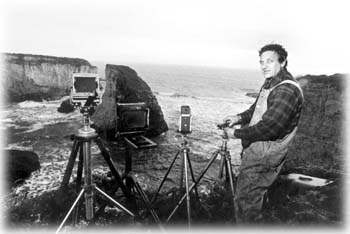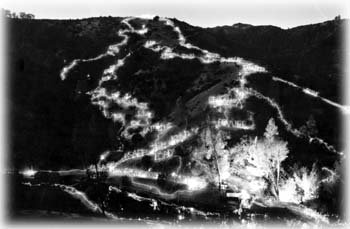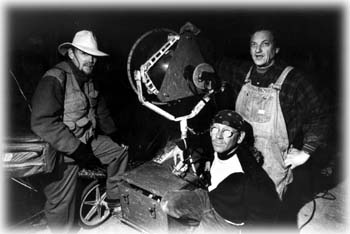![[MetroActive Arts]](/arts/gifs/art468.gif)
![[MetroActive Arts]](/arts/gifs/art468.gif)
[ Arts Index | Metro Santa Cruz | MetroActive Central | Archives ]
Power Flick People
Charge Card: Power Flick creator Gary Ruble sets up several of his high-intensity cameras on the North Coast cliffsides before a nighttime shoot.
Light bends and time melts when three old friends get together at a deserted North Coast beach to make an unusual kind of photograph
By Traci Hukill
AT THIS MOMENT, IT IS amusingly, poetically evident that the three men struggling to hoist a mounted searchlight over a roped-off road entrance are artists and not engineers. It's amusing because if they'd assembled the contraption--which must weigh 150 pounds--just 15 feet away on the other side of the rope, they could have avoided this whole backbreaking mess. It's poetic because nothing about what's going to happen here in the next six-and-a-half hours is practical, efficient or in any way necessary to the smooth functioning of the planet.
So it's really quite charming to watch three distracted and aging hippies working feverishly in the dark to get Big Light safely over the prohibitive rope and back on her three squeaking wheels so they can get on with the elastic photographic process they call a Power Flick.
The guys have ample reason to be distracted. Power Flicks are a lot of work. They require equipment, lanterns, extension cords and charcoal. This one needs darkness and a low tide, too, and the sun has already plunked into the ocean and the tide is dropping fast.
But the payoff for all this work will be magical--the three will get to stretch and pull time like so much dough and let it spring back into a single moment. They'll smear light over the cliffs of a dark empty cove as if it were creamy finger paint. They'll scatter ghosts across the mouth of a cave with a few tricks of light and chemistry.
For now, though, they have to get set up.
Mountain Do: Gary Ruble's 1972 "Power Flick #6" shows off the melting and bending effects of killer-watt Big Light on a North Coast hill.
The three ease Big Light to the ground like
litterbearers depositing a hefty queen. She is quite literally the star of this show, her 2,000-watt quartz halogen gaze the light that will paint the cliffs and the hulking chunk of granite in the North Coast sea. She used to be a shiplight, but now her silver parabolic reflector has been fused onto an old rusty tricycle frame for better maneuverability on land. The effect is one of rickety and alien elegance, like the lunar landing vehicles on Lost in Space.
Big Light always travels with a servant, a grumbling Honda generator trundling along on its own little chassis and reeking of gasoline. The two start to make their laborious way up the ridge overlooking the cove, two men pushing and pulling Big Light, one pushing the Honda, which fishtails a little like a faulty grocery cart.
There's some talking, a little laughter between the men. They've done this dozens of times since they first met in the mid-'70s, five years after Felton resident Gary Ruble photographed his first Power Flick with a buddy. Later Ruble, Marc Gould and Anders Tomlinson started doing Power Flicks in Granite Canyon south of Carmel and at Anza Borrego State Park near San Diego. Flicks were three-day affairs back then, involving cooking fires, jugs of water and a camp to keep the equipment dry.
Alternate realities, delicately termed "freakouts," used to be a crucial component of Power Flicks, too. Not tonight, though, with two visitors tagging along and some concern that the farmer who owns the neighboring artichoke field might show up, all apoplectic sound and fury, and order them off his easement road like Ruble saw him do to a few tourists yesterday. For this reason everyone's glad it's a late-rising moon tonight. The parked cars are hardly even visible from Highway 1.
We can see all we need to, though--the jeweled string of Davenport's lights a mile or so north, the cement plant's ominous glow and, due west, a choppy sea that looks colder now that every pale streak of color has vanished from the sky.
Ruble's been here since four o'clock this afternoon setting up cameras in places mountain goats fear to tread. On one such spot--the edge of an ice plantthronged bluff plunging 60 feet to the hard-packed sand below--a bank of four cameras balance on spindly tripod legs. Down on the steep trail to the beach, he's set up three more and opened all the cameras' shutters.
He really doesn't need this many. They're insurance for each other against the wild card of human error, which, as a matter of fact, is playing out right now--a lens cap is left on one camera as Big Light and her retinue reach the ridge on the cove's south side. For the moment, of course, nobody knows of anything amiss, and when Ruble discovers it he'll just chuckle.
Hooray for insurance.
The Light Brigade: Anders Tomlinson (left), Marc Gould and Gary Ruble, pioneers of the Power Flick, stand by their Big Light, a 2000-watt quartz spotlight they've wheeled along the cliffsides.
Three Guys and a Gal
ONCE MARC GOULD HAS maneuvered Big Light into place at the edge of a bluff overlooking dramatic granite cliff faces and the whitewater's rushing foam, the guys start up the Honda and plug the big gal in. The beam of light slices clean through the darkness, and Gould, playing lightman, settles into the rhythm of adjusting Big Light's gaze on the cliff faces every 30 seconds or so, his glasses winking in the light while he tells funny stories about Ruble.
Meanwhile Anders Tomlinson hangs back and says little--he's filming the whole thing for a KBCH RadioTV project. While Gould gears down to the slow process of washing the cliffs with light, Ruble takes off to build small charcoal fires under his cameras to keep moisture from the fog from condensing inside them.
For those whose minds don't dwell in the darkroom, the principle behind Power Flicks might need decoding. Briefly, all film needs light in order to produce an image. The dimmer the light source--and Big Light, for all her blinding intensity, is but a wee candle compared with the sun--the longer the camera's shutter needs to stay open in order to properly absorb the light. These cameras' shutters will be open for hours.
Ruble uses his light meter to determine that the film will require about 30 seconds of Big Light's undivided attention on a spot of cliff face in order to register it as light on the film. That's why Power Flicks take hours on end--spreading light on a cliff face is a time-devouring process even though the resulting photograph appears to represent a single moment.
An hour or so passes. Ruble has returned from firing up his impromptu hibachis and now it's time to roll Big Light over to another spot above the back curve of the cove. It's also time to animate a tunnel mouth on the beach using yet another perplexing combination of objects, light and time.
The cove's immensity looms up as we pick our way down a rocky trail with our few props--a fedora, a pig mask, a helmet made from a bucket and a magnesium flash bulb. Steep walls rise on three sides and granite scree litters the floor at the back wall.
The ceaseless waves have worn a tunnel through the rock on one side, but, alas, the tide has risen. Instead of dry sand at the tunnel's landward end, we have alternating scenarios of rushing ankle-deep whitewater and retreating foam. It'll have to do, though.
The resolute animators don fedora and bucket helmet and wait for the precise moment when the water is still retreating yet the next wave hasn't come in yet. Then they rush to the tunnel's entrance and gesticulate wildly while Ruble flashes the magnesium bulb. They repeat this peculiar act in different places, creating a village where only three people exist.
Since the ambient light is so dim, we can walk around the landscape undetected by the cameras unless one of two things happens. If we stand still with Big Light trained on us for 30 seconds or more, the film will absorb enough light to produce our image on film. Or if an exceedingly bright light--like the magnesium bulb--flashes for a split second, that will be sufficient light to burn our essence for that blink of time onto the film.
Ruble's shy about discussing his art. He shrugs off questions and says he just does it because he likes it. But something drives the guy--after all, he still has to position Big Light in a few more vantage places tonight, and it will be well into the small hours of the morning when they finally get the equipment broken down and loaded into the truck.
Maybe his next big project is what keeps him going. This Power Flick has been a practice run for a trip to the Southwest he just can't stop thinking about. The breathtaking monuments and the dry, scintillating air seem like the next logical place to go with Power Flicks. It will be their turn to be preserved in a single moment against a backdrop of eerily lit hours for all perpetuity.
Who suspected immortality was just a matter of chemical transfer?
This page was designed and created by the Boulevards team.

Robert Scheer
Gary Ruble
Robert Scheer
From the April 3-9, 1997 issue of Metro Santa Cruz
Copyright © 1997 Metro Publishing, Inc.